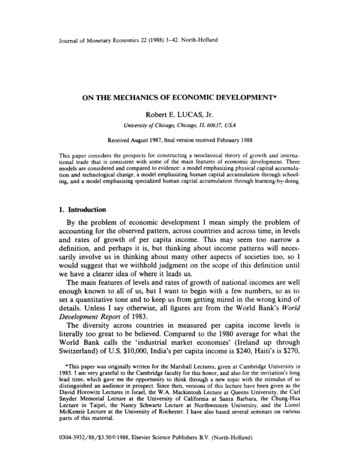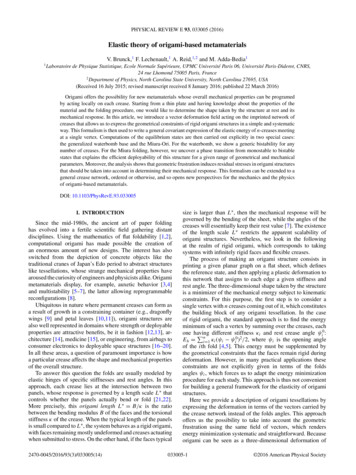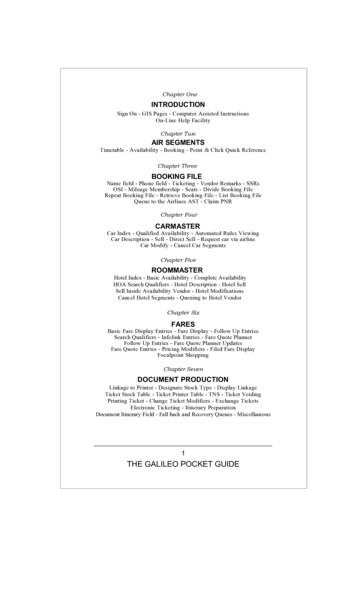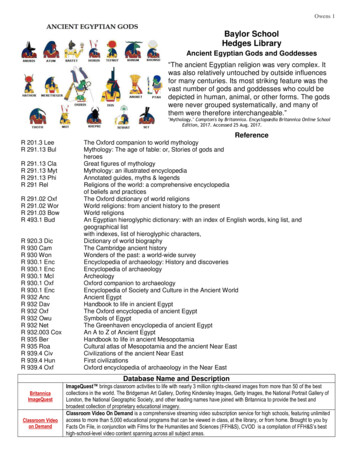
Transcription
Journal of Monetary Economics 22 (1988) 3-42. North-HollandON THE MECHANICS OF ECONOMIC DEVELOPMENT*Robert E. LUCAS, Jr.University of Chicago, Chicago, 1L 60637, USAReceived August 1987, final version received February 1988This paper considers the prospects for constructing a neoclassical theory of growth and international trade that is consistent with some of the main features of economic development. Threemodels are considered and compared to evidence: a model emphasizing physical capital accumulation and technological change, a model emphasizing human capital accumulation through schooling. and a model emphasizing specialized human capital accumulation through learning-by-doing.1. IntroductionBy the problem of economic development I mean simply the problem ofaccounting for the observed pattern, across countries and across time, in levelsand rates of growth of per capita income. This may seem too narrow adefinition, and perhaps it is, but thinking about income patterns will necessarily involve us in thinking about many other aspects of societies too. so Iwould suggest that we withhold judgment on the scope of this definition untilwe have a clearer idea of where it leads us.The main features of levels and rates of growth of national incomes are wellenough known to all of us, but I want to begin with a few numbers, so as toset a quantitative tone and to keep us from getting mired in the wrong kind ofdetails. Unless I say otherwise, all figures are from the World Bank's WorldDevelopment Report of 1983.The diversity across countries in measured per capita income levels isliterally too great to be believed. Compared to the 1980 average for what theWorId Bank calls the 'industrial market economies' (Ireland up throughSwitzerland) of U.S. 10,000, India's per capita income is 240, Haiti's is 270,*This paper was originally written for the Marshall Lectures, given at Cambridge University in1985. ! am very grateful to the Cambridge faculty for this honor, and also for the invitatiou's longlead time, which gave me the opportunity to think through a new topic with the stimulus of sodistinguished an audience in prospect. Since then, versions of this lecture have been given as theDavid Horowitz Lectures in Israel, the W.A. Mackintosh Lecture at Queens University, the CarlSnyder Memorial Lecture at the University of California at Santa Barbara, the Chung-HuaLecture in Taipei. the Nancy Schwartz Lecture at Northwestern University, and the LionelMcKenzie Lecture at the University of Rochester. I have also based several seminars on variousparts of this material.0304-3932j88j 3.50 1988, Elsevier Science Publishers B.V. (North-Holland)
4R. E. Lucas, Jr., On the mechanics of economic developmentand so on for the rest of the very poorest countries. This is a difference of afactor of 40 in living standards! These latter figures are too low to sustain lifein, say, England or the United States, so they cannot be taken at face valueand I will avoid hanging too much on their exact magnitudes. But I do notthink anyone will argue that there is not enormous diversity in living standards. IRates of growth of real per capita GNP are also diverse, even over sustainedperiods. For 1960-80 we observe, for example: India, 1.4% per year; Egypt,3.4%; South Korea, 7.0%; Japan, 7.1 %; the United States, 2.3%; the industrialeconomies averaged 3.6%. To obtain from growth rates the number of years ittakes for incomes to double, divide these numbers into 69 (the log of 2 times100). Then Indian incomes will double every 50 years; Korean every 10. AnIndian will, on average, be twice as well off as his grandfather; a Korean 32times. These differences are at least as striking as differences in income levels,and in some respects more trustworthy, since within-country income comparisons are easier to draw than across-country comparisons.I have not calculated a correlation across countries between income levelsand rates of growth, but it would not be far from zero. (The poorest countriestend to have the lowest growth; the wealthiest next; the 'middle-income'countries highest.) The generalizations that strike the eye have to do withvariability within these broad groups: the rich countries show little diversity(Japan excepted - else it would not have been classed as a rich country in1980 at all). Within the poor countries (low and middle income) there isenormous variability. 2Within the advanced countries, growth rates tend to be very stable over longperiods of time, provided one averages over periods long enough to eliminatebusiness-cycle effects (or corrects for short-term fluctuations in some otherway). For poorer countries, however, there are many examples of sudden, largechanges in growth rates, both up and down. Some of these changes are nodoubt due to political or military disruption: Angola's total GDP growth fellfrom 4.8 in the 60s to - 9.2 in the 70s; Iran's fell from 11.3 to 2.5, comparingthe same two periods. I do not think we need to look to economic theory foran account of either of these declines. There are also some striking examples1 The income estimates reported in Summers and Heston (1984) are more satisfactory than thosein the World Development Reports. In 1975 U.S. dollars, these authors estimate 1980 U.S. realGDP per capita at 8000, and for the industrialized economies as a group, 5900. The comparablefigures for India and Haiti are 460 and 500, respectively. Income differences of a factor of 16 arecertainly smaJler, and J think more accurate, than a factor of 40, but I think they are still fairlydescribed as exhibiting 'enormous diversity'.2 Baumol (1986) summarizes evidence, mainly from Maddison (1982) indicating apparentconvergence during this century to a common path of the income levels of the wealthiestcountries. But De Long (1987) shows that this effect is entirely due to 'selection bias': If oneexamines the countries with the highest income levels at the beginning of the century (as opposedto currently, as in Maddison's 'sample') the data show apparent divergence!
R.E. Lucas. Jr., On the mechanics of economic development5of sharp increases in growth rates. The four East Asian 'miracles' of SouthKorea, Taiwan, Hong Kong and Singapore are the most familiar: for the1960-80 period, per capita income in these economies grew at rates of 7.0, 6.5,6.8 and 7.5, respectively, compared to much lower rates in the 1950's andearlier. 3,4 Between the 60s and the 70s, Indonesia's GDP growth increasedfrom 3.9 to 7.5; Syria's from 4.6 to 10.0.I do not see how one can look at figures like these without seeing them asrepresenting possibilities. Is there some action a government of India couldtake that would lead the Indian economy to grow like Indonesia's I)r Egypt's?If so, what, exactly? If not, what is it about the' nature of India' that makes itso? The consequences for human welfare involved in questions like these aresimply staggering: Once one starts to think about them, it is hard to thinkabout anything else.This is what we need a theory of economic development for: to providesome kind of framework for organizing facts like these, for judging whichrepresent opportunities and which necessities. But the term' theory' is used inso many different ways, even within economics, that if I do not clarify what Imean by it early on, the gap between what I think I am saying and what youthink you are hearing will grow too wide for us to have a serious discussion. Iprefer to use the term' theory' in a very narrow sense, to refer to an explicitdynamic system, something that can be put on a computer and run. This iswhat I mean by the' mechanics' of economic development - the constructionof a mechanical, artificial world, populated by the interacting robots thateconomics typically studies, that is capable of exhibiting behavior the grossfeatures of which resemble those of the actual world that I have just described.My lectures will be occupied with one such construction, and it will take somework: It is easy to set out models of economic growth based on reasonablelooking axioms that predict the cessation of growth in a few decades, or thatpredict the rapid convergence of the living standards of different economies toa common level, or that otherwise produce logically possible outcomes thatbear no resemblance to the outcomes produced by actual economic systems.On the other hand, there is no doubt that there must be mechanics other thanthe ones I will describe that would fit the facts about as well as mine. This iswhy I have titled the lectures 'On the Mechanics . ' rather than simply 'TheMechanics of Economic Development'. At some point, then, the study ofdevelopment will need to involve working out the implications of competingtheories for data other than those they were constructed to fit, and testingthese implications against observation. But this is getting far ahead of the3The World Bank no longer transmits data for Taiwan. The figure 6.5 in the text is fromHarberger (1984, table 1, p. 9).4According to Heston and Summers (1984), Taiwan's per-capita GDP growth rate in the 1950swas 3.6. South Korea's was 1.7 from 1953 to 1960.
6R.E. Lucas. Jr., On the mechanics of economic developmentstory I have to tell, which will involve leaving many important questions openeven at the purely theoretical level and will touch upon questions of empiricaltesting hardly at all.My plan is as follows. I will begin with an application of a now-standardneoclassical model to the study of twentieth century U.S. growth, closelyfollowing the work of Robert Solow, Edward Denison and many others. I willthen ask, somewhat unfairly, whether this model as it stands is an adequatemodel of economic development, concluding that it is not. Next, I willconsider two adaptations of this standard model to include the effects ofhuman capital accumulation. The first retains the one-sector character of theoriginal model and focuses on the interaction of physical and human capitalaccumulation. The second examines a two-good system that admits specializedhuman capital of different kinds and offers interesting possibilities for theinteraction of trade and development. Finally, I will turn to a discussion ofwhat has been arrived at and of what is yet to be done.In general, I will be focusing on various aspects of what economists, usingthe term very broadly, call the' technology'. I will be abstracting altogetherfrom the economics of demography, taking population growth as a giventhroughout. This is a serious omission, for which I can only offer the excusethat a serious discussion of demographic issues would be at least as difficult asthe issues I will be discussing and I have neither the time nor the knowledge todo both. I hope the interactions between these topics are not such that theycannot usefully be considered separately, at least in a preliminary way. 5I will also be abstracting from all monetary matters, treating all exchange asthough it involved goods-for-goods. In general, I believe that the importanceof financial matters is very badly over-stressed in popular and even muchprofessional discussion and so am not inclined to be apologetic for going tothe other extreme. Yet insofar as the development of financial institutions is alimiting factor in development more generally conceived I will be falsifying thepicture, and I have no clear idea as to how badly. But one cannot theorizeabout everything at once. I had better get on with what I do have to say.2. Neoclassical growth theory: ReviewThe example, or model, of a successful theory that I will try to build on isthe theory of economic growth that Robert Solow and Edward Denisondeveloped and applied to twentieth century U.S. experience. This theory willserve as a basis for further discussion in three ways: as an example of the formthat I believe useful aggregative theories must take, as an opportunity to5Becker and Barro (1985) is the first attempt known to me to analyze fertility and capitalaccumulation decisions simultaneously within a general equilibrium framework. Tamura (1986)contains further results along this line.
R.E. Lucas, Jr., On the mechanics of economic development7explain exactly what theories of this form can tell us that other kinds oftheories cannot, and as a possible theory of economic development. In thisthird capacity, the theory will be seen to fail badly, but also suggestively.Following up on these suggestions will occupy the remainder of the lectures.Both Solow and Denison were attempting to account for the main featuresof U.S. economic growth, not to provide a theory of economic development,and their work was directed at a very different set of observations from thecross-country comparisons I cited in my introduction. The most usefulsummary is provided in Denison's 1961 monograph, The Sources of EconomicGrowth in the United States. Unless otherwise mentioned, this is the source forthe figures I will cite next.During the 1909-57 period covered in Denison's study, U.S. real outputgrew at an annual rate of 2.9%, employed manhours at 1.3%, and capital stockat 2.4%. The remarkable feature of these figures, as compared to those citedearlier, is their stability over time. Even if one takes as a starting point thetrough of the Great Depression (1933) output growth to 1957 averages only5%. If business-cycle effects are removed in any reasonable way (say, by usingpeak-to-peak growth rates) U.S. output growth is within half a percentagepoint of 3% annually for any sizeable subperiod for which we have data.Solow (1956) was able to account for this stability, and also for some of therelative magnitudes of these growth rates, with a very simple but also easilyrefineable model. 6 There are many variations of this model in print. I will setout a particularly simple one that is chosen also to serve some later purposes. Iwill do so without much comment on its assumed structure: There is no pointin arguing over a model's assumptions until one is clear on what questions itwill be used to answer.We consider a closed economy with competitive markets, with identical,rational agents and a constant returns technology. At date t there are N( t)persons or, equivalently, manhours devoted to production. The exogenouslygiven rate of growth of N( t) is A. Real, per-capita consumption is a streamc(t), t 0, of units of a single good. Preferences over (per-capita) consumptionstreams are given byooioe-pt l [c(t)l-o-I]N(t)dt,I-a(1)6 Solow's 1956 paper stimulated a vast literature in the 1960s, exploring many variations on theoriginal one-sector structure. See Burmeister and Dobell (1970) for an excellent introduction andsurvey. By putting a relatively simple version to empirical use, as I shall shortly do, I do notintend a negative comment on this body of research. On the contrary, it is exactly this kind oftheoretical experimentation with alternative assumptions that is needed to give one the confidencethat working with a particular, simple parameterization may, for the specific purpose at hand, beadequate.
R.E. Lucas, Jr., On the mechanics of economic development8where the discount rate p and the coefficient of (relative) risk aversion 0 areboth positive. 7Production per capita of the one good is divided into consumption c( t) andcapital accumulation. If we let K(t) denote the total .stock of cal?ital, andK(t) its rate of change, then total output is N(t)c(t) K(t). [Here K(t) is netinvestment and total output N(t)c(t) K(t) is identified with net nationalproduct.] Production is assumed to depend on the levels of capital and laborinpu ts and on the level A ( t) of the 'technology', according to(2)where 0 f3 1 and where the exogenously given rate of technical change,A/A, is p. O.The resource allocation problem faced by this simple economy is simply tochoose a time path c( t) for per-capita consumption. Given a path c(t) and aninitial capital stock K(O), the technology (2) then implies a time path K( t) forcapital. The paths A(t) and N(t) are given exogenously. One way to thinkabou t this allocation problem is to think of choosing c(t) at each date, giventhe values of K(t), A(t) and N(t) that have been attained by that date.Evidently, it will not be optimal to choose c( t) to maximize current-periodutility, N(t)[1j(1 - o)][c(t) - 1]1-0, for the choice that achieves this is to setnet investment K(t) equal to zero (or, if feasible, negative): One needs to setsome value or price on increments to capital. A central construct in the studyof optimal allocations, allocations that maximize utility (1) subject to thetechnology (2), is the current-value Hamiltonian H defined byH(K, 8, c,t)N -1-[c 1-0O-1] 8[AK.8N 1-.8 - Nc],which is just the sum of current-period utility and [from (2)] the rate ofincrease of capital, the latter valued at the' price' 8( t). An optimal allocationmust maximize the expression H at each date t, provided the price O( t) iscorrectly chosen.The first-order condition for maximizing H with respect to c is(3)which is to say that goods must be so allocated at each date as to be equallyvaluable, on the margin, used either as consumption or as investment. It is7The inverse a -I of the coefficient of risk aversion is sometimes called the intertemporalelasticity of substitution. Since all the models considered in this paper are deterministic, this latterterminology may be more suitable.
R.E. Lucas, Jr., On the mechanics 0/ economic development9known that the price 8( t) must satisfy.a8(t) p8(t) - aKH(K(t),8(t),c(t), t) [p - f3A ( t ) N ( t )1-f3 K ( t ) f3 - 1] 8( t ) ,(4)at each date t if the solution c(t) to (3) is to yield an optimal path (c(t» o.Now if (3) is used to express c(t) as a function 8(1), and this function 8- 1/is substituted in place of c(t) in (2) and (4), these two equations are a pair offirst-order differential equations in K (t) and its 'price' 8(1). Solving thissystem, there will be a one-parameter family of paths (K (t), 8( t», satisfyingthe given initial condition on K(O). The unique member of this family thatsatisfies the transversality condition:0lim e- pt8(t)K(t) 0(5)t- 00is the optimal path. I am hoping that this application of Pontryagin's Maximum Principle, essentially taken from David Cass (1961), is familiar to mostof you. I will be applying these same ideas repeatedly in what follows.For this particular model, with convex preferences and technology and withno external effects of any kind, it is also known and not at all surprising thatthe optimal program characterized by (2), (3), (4) and (5) is also the uniquecompetitive equilibrium program, provided either that all trading is consummated in advance, Arrow-Debreu style, or (and this is the interpretation Ifavor) that consumers and firms have rational expectations about future prices.In this deterministic context, rational expectations just means perfect foresight. For my purposes, it is this equilibrium interpretation that is mostinteresting: I intend to use the model as a positive theory of U.S. economicgrowth.In order to do this, we will need to work out the predictions of the model inmore detail, which involves solving the differential equation system so we cansee what the equilibrium time paths look like and compare them to observations like Denison's. Rather than carry this analysis through to completion, Iwill work out the properties of a particular solution to the system and thenjust indicate briefly how the rest of the answer can be found in Cass's paper.Let us construct from (2), (3) and (4) the system's balanced growth path: theparticular solution (K(t), 8(1), c(t» such that the rates of growth of each ofthese variables is constant. (I have never been sure exactly what it is that is'balanced' along such a path, but we need a term for solutions with thisconstant growth rate property and this is as good as any.) Let K denote therate of growth of per-capita consumption, c(t)jc(t), on a balanced growth
R.E. Lucas, Jr., On the mechanics of economic development10path. Then from (3), we have 8(t)/8(t) -al(. Then from (4), we must havef3A ( t ) N ( t ) 1 - fJ K ( t ) fJ - 1 P aI( .(6)That is, along the balanced path, the marginal product of capital must equalthe constant value p al(. With this Cobb-Douglas technology, the marginalproduct of capital is proportional to the average product, so that dividing (2)through by K( t) and applying (6) we obtainN(t)c(t)K(t) A( )K( )fJ-11t.T( )l- fJ p al(K(t) K(t)ttiV t13'(7)By definition of a balanced path, K(t)/K(t) is constant so (7) implies thatN( t )c(t)/K( t) is constant or, differentiating, thatK(t)N(t)c(t)K(t)N(t)c(t)-- -- -- I( A.(8)Thus per-capita consumption and per-capita capital grow at the commonrate 1(. To solve for this common rate, differentiate either (6) or (7) to obtainp.(9)1( - - .1-13Then (7) may be solved to obtain the constant, balanced consumption-capitalratio N(t)c(t)/K(t) or, which is equivalent and slightly easier to interpret, theconstant, balanced net savings rate s defined bys K(t)N(t)c(t) K(t)f3(I( A) ---p al('(10)Hence along a balanced path, the rate of growth of per-capita magnitudes issimply proportional to the given rate of technical change, p., where theconstant of proportionality is the inverse of labor's share, 1 - 13. The rate oftime preference p and the degree of risk aversion a have no bearing on thislong-run growth rate. Low time preference p and low risk aversion a induce ahigh savings rate s, and high savings is, in turn, associated with relatively highoutput levels on a balanced path. A thrifty society will, in the long run, bewealthier than an impatient one, but it will not grow faster.In order that the balanced path characterized by (9) and (10) satisfy thetransversality condition (5), it is necessary that p al( I( A. [From (10), onesees that this is the same as requiring the savings rate to be less than capital's
R.E. Lucas, Jr., On the mechanics of economic development11share.] Under this condition, an economy that begins on the balanced pathwill find it optimal to stay there. What of economies that begin off thebalanced path - surely the normal case? Cass showed - and this is exactlywhy the balanced path is interesting to us - that for any initial capitalK(O) 0, the optimal capital-consumption path (K(t), c(t» will converge tothe balanced path asymptotically. That is, the balanced path will be a goodapproximation to any actual path 'most' of the time.Now given the taste and technology parameters (p, 0, X, f3 and JL) (9) and(10) can be solved for the asymptotic growth rate K of capital, consumptionand real output, and the savings rate s that they imply. Moreover, it would bestraightforward to calculate numerically the approach to the balanced pathfrom any initial capital level K (0). This is the exercise that an idealizedplanner would go through.Our interest in the model is positive, not normative, so we want to go in theopposite direction and try to infer the underlying preferences and technologyfrom what we can observe. I will outline this, taking the balanced path as themodel's prediction for the behavior of the U.S. economy during the entire(1909-57) period covered by Denison's study.8 From this point of view,Denison's estimates provide a value of 0.013 for X, and two values, 0.029 and0.024 for K X, depending on whether we use output or capital growth rates(which the model predicts to be equal). In the tradition of statistical inference,let us average to get K X 0.027. The theory predicts that 1 - f3 shouldequal labor's share in national income, about 0.75 in the U.S., averaging overthe entire 1909-57 period. The savings rate (net investment over NNP) isfairly constant at 0.10. Then (9) implies an estimate of 0.0105 for JL. Eq. (10)implies that the preference parameters p and 0 satisfyp (0.014)0 0.0675.(The parameters p and 0 are not separately identified along a smoothconsumption path, so this is as far as we can go with the sample averages Ihave provided.)These are the parameter values that give the theoretical model its best fit tothe U.S. data. How good a fit is it? Either output growth is underpredicted orcapital growth overpredicted, as remarked earlier (and in the theory of growth,a half a percentage point is a large discrepancy). There are interesting secularchanges in manhours per household that the model assumes away, and labor'sshare is secularly rising (in all growing economies), not constant as assumed.There is, in short, much room for improvement, even in accounting for thesecular changes the model was designed to fit, and indeed, a fuller review of8With the parameter values described in this paragraph, the half-life of the approximate linearsystem associated with this model is about eleven years.
12R.E. Lucas, Jr., On the mechanics of economic developmentthe literature would reveal interesting progress on these and many otherfronts. 9 A model as explicit as this one, by the very nakedness of its simplifying assumptions, invites criticism and suggests refinements to itself. This isexactly why we prefer explicitness, or why I think we ought to.Even granted its limitations, the simple neoclassical model has made basiccontributions to our thinking about economic growth. Qualitatively, it emphasizes a distinction between 'growth effects' - changes in parameters that altergrowth rates along balanced paths - and 'level effects' - changes that raise orlower balanced growth paths without affecting their slope - that is fundamental in thinking about policy changes. Solow's 1956 conclusion that changes insavings rates are level effects (which transposes in the present context to theconclusion that changes in the discount rate, P, are level effects) was startlingat the time, and remains widely and very unfortunately neglected today. Theinfluential idea that changes in the tax structure that make savings moreattractive can have large, sustained effects on an economy's growth ratesounds so reasonable, and it may even be true, but it is a clear implication ofthe theory we have that it is not.Even sophisticated discussions of economic growth can often be confusingas to what are thought to be level effects and what growth effects. ThusKrueger (1983) and Harberger (1984), in their recent, very useful surveys ofthe growth experiences of poor countries, both identify inefficient barriers totrade as a limitation on growth, and their removal as a key explanation ofseveral rapid growth episodes. The facts Krueger and Harberger summarizeare not in dispute, but under the neoclassical model just reviewed one wouldnot expect the removal of inefficient trade barriers to induce sustainedincreases in growth rates. Removal of trade barriers is, on this theory, a leveleffect, analogous to the one-time shifting upward in production possibilities,and not a growth effect. Of course, level effects can be drawn out through timethrough adjustment costs of various kinds, but not so as to produce increasesin growth rates that are both large and sustained. Thus the removal of aninefficiency that reduced output by five percent (an enormous effect) spreadout over ten years in simply a one-half of one percent annual growth ratestimulus. Inefficiencies are important and their removal certainly desirable, butthe familiar ones are level effects, not growth effects. (This is exactly why it isnot paradoxical that centrally planned economies, with allocative inefficienciesof legendary proportions, grow about as fast as market economies.) Theempirical connections between trade policies and economic growth that9In particular, there is much evidence that capital stock growth, as measured by Denison,understates true capital growth due to the failure to correct price deflators for quality improvements. See, for example, Griliches and Jorgenson (1967) or Gordon (1971). These errors may wellaccount for all of the 0.005 discrepancy noted in the text (or more!).Boxall (1986) develops a modification of the Solow-Cass model in which labor supply isvariable, and which has the potential (at least) to account for long-run changes in manhours.
R. E. Lucas, Jr., On the mechanics of economic development13Krueger and Harberger document are of evident importance, but they seem tome to pose a real paradox to the neoclassical theory we have, not a confirmation of it.The main contributions of the neoclassical framework, far more importantthan its contributions to the clarity of purely qualitative discussions, stemfrom its ability to quantify the effects of various influences on growth.Denison's monograph lists dozens of policy changes, some fanciful and manyothers seriously proposed at the time he wrote, associating with each of themrough upper bounds on their likely effects on U.S. growth. 1o In the main, thetheory adds little to what common sense would tell us about the direction ofeach effect - it is easy enough to guess which changes stimulate production,hence savings, and hence (at least for a time) economic growth. Yet most suchchanges, quantified, have trivial effects: The growth rate of an entire economyis not an easy thing to move around.Economic growth, being a summary measure of all of the activities of anentire society, necessarily depends, in some way, on everything that goes on ina society. Societies differ in many easily observed ways, and it is easy toidentify various economic and cultural peculiarities and imagine that they arekeys to growth performance. For this, as Jacobs (1984) rightly observes, we donot need economic theory: 'Perceptive tourists will do as well.' The role oftheory is not to catalogue the obvious, but to help us to sort out effects thatare crucial, quantitatively, from those that can be set aside. Solow andDenison's work shows how this can be done in studying the growth of the U.S.economy, and of other advanced economies as well. I take success at this levelto be a worthy objective for the theory of ec
Journal of Monetary Economics 22 (1988) 3-42.North-Holland ON THE MECHANICS OF ECONOMIC DEVELOPMENT* Robert E. LUCAS, Jr. University ofChicago, Chicago, 1L 60637, USA Received August 1987, final version received February 1988 This paper considers the prospects for constructing a neoclassical theory of growth and interna











